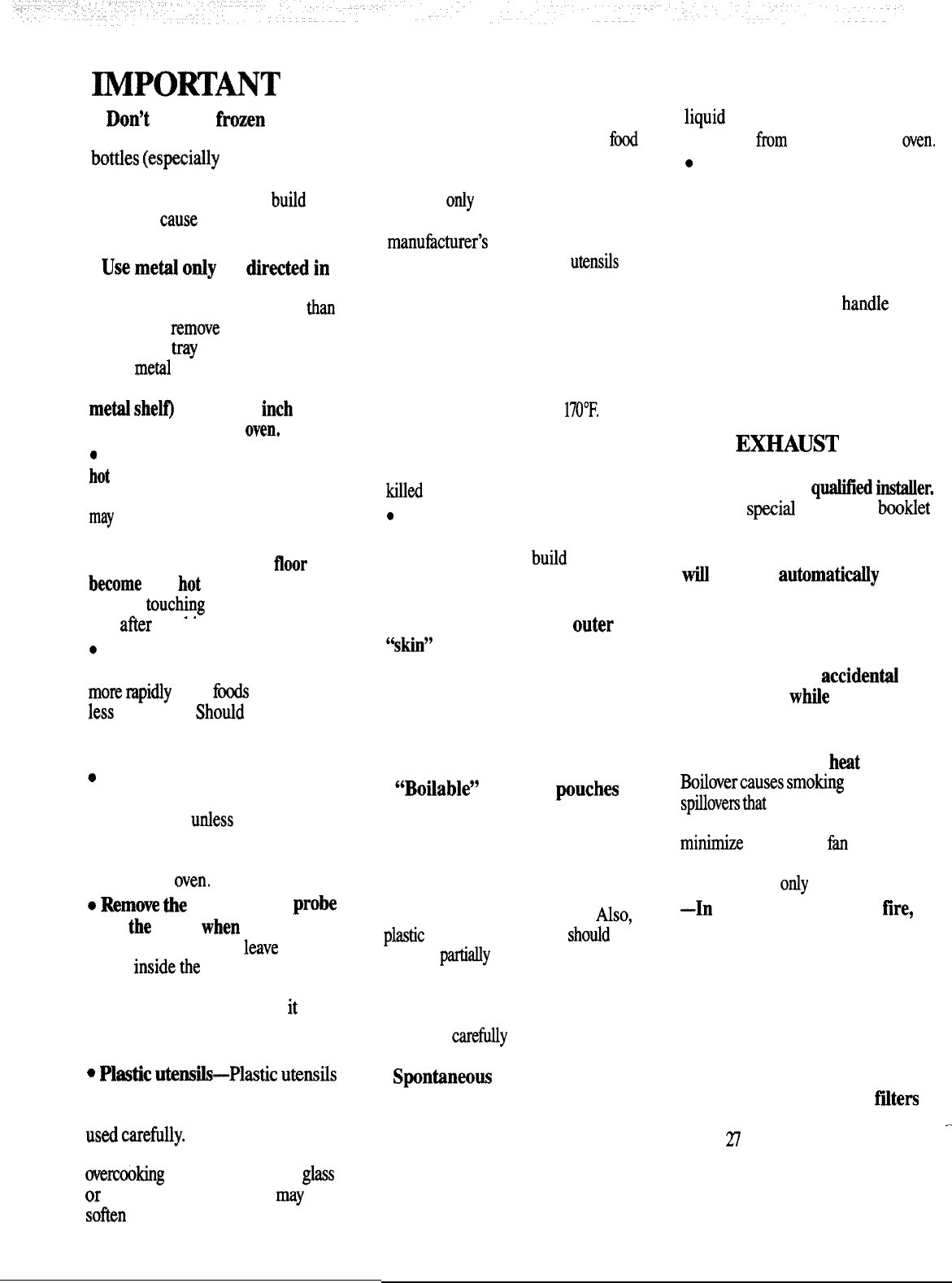
mPORTmT
SAFETY INSTRUCTIONS
(continued)
*
Don’t
defrost
frozen
beverages in narrow necked
botties
(Qspecidly
carbonated
beverages), Even if the container
is opened, pressure can
butid
up.
This can
cause
the container to
burst, resulting in injury.
●
Use
meti
o~y
as
direeted
in
cookbook.
TV dinners maybe
microwaved in foil trays less
tian
3/4” high;
remove
top foil cover
and return
tray
to box. When
using
metal
in the microwave
oven,
keep metal (other than
mti
shel~
at least 1
inch
away from sides of
oven.
Q
Cooking utensils may become
hot
because of heat transferred
from the heated food.
Pot
holders
may
be needed to handle the
utensil.
* Sometimes, the oven
floor
can
become
too
hot
to touch.
Be
careful
touchi~g
the floor during
and
akr
cooking.
*
Foods cooked in liquids (such
as pasta) may tend to boil over
mom
mpi~y
than
fti
containing
less
moisture.
Shotid
this occur,
refer to page 28 for instructions on
how to clean the inside of the oven.
@
Thermometer—Do not use
a thermometer in food you are
microwaving
udess the
thermometer is designed or
recommended for use in the
microwave
oven.
*
Remove
the
temperature
p~~
from
the
oven
when
not
using it
to cook with. If you
leave
the
probe
inside
the
oven without
inserting it in food or liquid, and
turn on microwave energy,
it
can
create electrical arcing in the
oven and damage oven walls,
@
Phtic
utens&-Plastic
utensfls
designed for microwave cooking
are very useful, but should be
usti
carefi~y.
Even microwave
plastic may not be as tolerant of
ovetiking
conditions as are
@ass
or
ceramic materials and
may
sofien
or char if subjected to short
periods of overcooking. In longer
exposures to overcooking, the
fd
and utensils could ignite, For
these reasons: 1) Use microwave
plastics
ordy
and use them in strict
compliance with the utensil
manuticturer’s
recommendations.
2) Do not subject empty
utensfls
to
microwaving. 3) Do not permit
children to use plastic utensils
without complete supervision.
●
When cooking pork, follow
our directions exactly and always
cook the meat to an internal
temperature of at least
l~°F.
This assures that, in the remote
possibility that trichina may be
present in the meat, it will be
tiled
and meat will be safe to eat.
Q
Boiling eggs is not
recommended
in a microwave
oven. Pressure can
bufld
up
inside egg yolk and may cause
it to burst, resulting in injury.
●
Foods with unbroken
outer
“skin”
such as potatoes,
sausages, tomatoes, apples,
chicken livers and other giblets,
and egg yolks (see previous
caution) should be pierced to
allow steam to escape during
cooking.
.
g$Boilab~e”
cooking
~uch~
and tightly
closed plastic bags
should be slit, pierced or vented
as directed in cookbook. If they
are not, plastic could burst during
or immediately after cooking,
possibly resulting in injury.
Mso,
phtic
storage containers
shodd
be
at least
partidy
uncovered because
they form a tight seal. When
cooking with containers tightly
covered with plastic wrap, remove
covering
carefu~y
and direct steam
away from hands and face.
●
SPntineous
boiling—under
certain special circumstances,
liquids may start to boil during or
shortly after removal from the
microwave oven. To prevent burns
from splashing liquid, stir the
4
liquid
briefly before removing the -
container
fmm
the microwave
oven,
Q
Use of the shelf accessory.
—Remove the shelf from oven
when not in use.
–Do not store or cook with shelf
on floor of oven. Product damage
may result.
–Use pot holders to
handle
shelf
and utensils, They may be hot.
—Do not use microwave browning
dish on shelf; the shelf could
overheat. Do not use shelf with
Automatic Cooking feature.
THE
~~UST
HOOD
●
Have it installed and properly
grounded by a
qtied
instier,
See the
spccid
initiation
bootiet
packed with the microwave oven.
●
The exhaust fan in your oven
W
operate
automatidy
under
certain conditions (see Automatic
Fan Feature, page 6). While the -
fan is operating, caution is
required to prevent the starting
and spreading of
accidenti
cooking fires
whtie
the exhaust
fan is in use. For this reason:
–Never leave surface units
unattended at high
hat
settings.
Bodovercausessmoking
and greasy
sptioversthat
may ignite and spread
if exhaust fan is operating, To
mi-
automatic
M
operation,
use adequate sized utensils and
use high heat ody when necessary.
—In
the event of a grease
fire,
smother flaming pan on surface
unit by covering pan completely
with well-fitting lid, cookie sheet
or flat tray.
–Never flame foods under
the oven with the exhaust fan
operating because it may spread
the flames.
–Keep hood and grease
fiiters
clean, according to instructions on
_
pages
~
and 29, to maintain good
venting and avoid grease fires.
SAVE THESE
INSTRUCTIONS


















